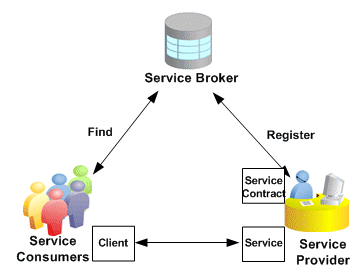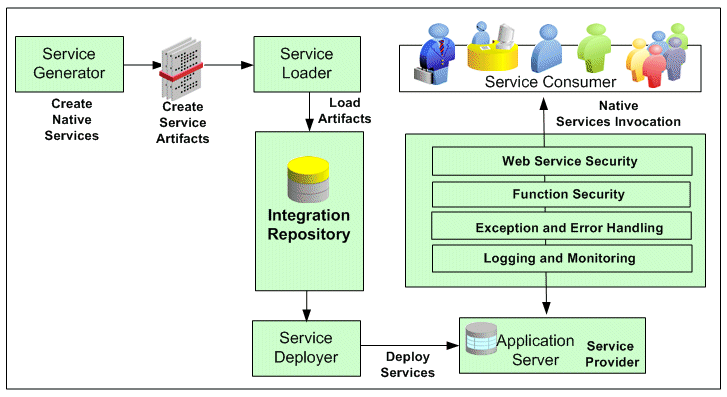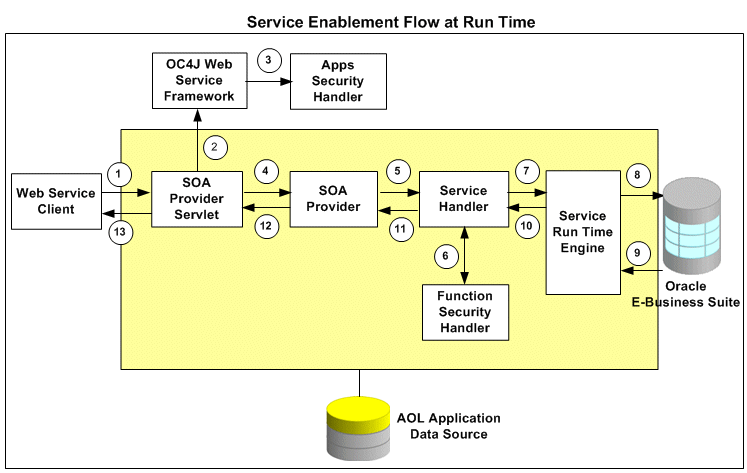Release 12.1
Part Number E12169-06
Contents
Previous
Next
| Oracle E-Business Suite Integrated SOA Gateway Implementation Guide Release 12.1 Part Number E12169-06 | Contents | Previous | Next |
This chapter covers the following topics:
Building on top of Oracle Fusion Middleware and service-oriented architecture (SOA) technology, Oracle E-Business Suite Integrated SOA Gateway (ISG) provides a customer-focused robust communication and integration infrastructure between independently managed components and loosely coupled applications. This infrastructure not only allows greater and effective business integration between heterogeneous applications, but also facilitates the development and execution of complex business processes into highly flexible and reusable Web services. With this standardized and interoperable Web service platform, Oracle E-Business Suite Integrated SOA Gateway provides a powerful framework that accelerates dynamic business processes and service integration between applications over the Web.
Oracle E-Business Suite Integrated SOA Gateway is a complete set of service infrastructure. It supports almost all integration interface types and services invoked within Oracle E-Business Suites no matter if they are native packaged interfaces or the services that are orchestrated using native services. With this pre-built, reusable business services and service-oriented components, Oracle E-Business Suite Integrated SOA Gateway provides a capability of allowing various users to perform different tasks and to monitor and manage service integration throughout the entire service deployment life cycle.
For example, system integration developers can perform end-to-end service integration activities including orchestrating discrete Web services into meaningful end-to-end business processes, defining Web service invocation metadata, and testing the Web service invocation.
Application users or system integration analysts can then browse through and search on available integration interfaces and services as well as view each interface details through the centralized repository.
Integration repository administrators can take further actions on transforming native interfaces into Web services, and then deploying the services for public use and access. The administrators are also responsible for enforcing service related securities, monitoring and managing the entire integrated service deployment life cycle to ensure smooth service integration between applications.
With pre-built, reusable business services and an essential service-oriented framework allowing service generation, deployment, invocation, and management, Oracle E-Business Suite Integrated SOA Gateway is the intrinsic part of Oracle E-Business Suite for service enablement. It not only enables services within and beyond Oracle E-Business Suite, but also facilitates dynamic business execution through a seamless service integration and consumption over the internet.
For more information about each integration interface and service, see Oracle E-Business Suite Integrated SOA Gateway User's Guide; for more information about Web service invocation and performing service integration activities, see Oracle E-Business Suite Integrated SOA Gateway Developer's Guide.
Oracle E-Business Suite Integrated SOA Gateway contains the following features:
Provide robust, consistent integration framework with extensive infrastructure based on SOA principles
Integrate loosely coupled and heterogeneous applications
Contain pre-built and reusable business services
Provide native service enablement capability within the Oracle E-Business Suite
Use native services as building blocks to create composite services
Support annotated custom integration interfaces from Oracle Integration Repository
Enforce function security and role-based access control security to allow only authorized users to execute administrative functions
Support multiple authentication types for inbound service requests in securing Web service content and authenticating Web service operations
Provide centralized, user-friendly user interface for logging configuration
Enable Web service invocation from Oracle E-Business Suite
Audit and monitor Oracle E-Business Suite service operations from SOA Monitor
The better understand Oracle E-Business Suite Integrated SOA Gateway and its key components, this section describes some key features and the definition of each component.
Service enablement is the key feature within Oracle E-Business Suite Integrated SOA Gateway. It provides a mechanism that allows native packaged integration interface definitions residing in Oracle Integration Repository to be further transformed into Web services that comply with Web standards. Additionally, these services can be deployed from the Integration Repository to the application server allowing more consumptions over the Web.
To understand the basic concept of Web services and how the service works, the following diagram illustrates the essential components of enabling services:

A Service Provider is the primary engine underlying the Web services. It facilitates the service enablement for various types of interfaces.
A Service Consumer (Web service client) is the party that uses or consumes the services provided by the Service Provider.
A Service Broker (Service Registry) describes the service's location and contract to ensure service information is available to any potential service consumer.
Composite services use the native service as building blocks to construct the sequence of business flows. Basically, this interface type orchestrates the invocation sequence of discrete Web services into a meaningful end-to-end business process through a Web service composition language BPEL (business process execution language).
For example, use Oracle BPEL Process Manager (BPEL PM) to integrate the Order-to-Receipt business process that contains sales order entry, item availability check, pack and ship, and invoice to Accounts Receivable sub processes handled by various applications. This approach effectively tightens up the control of each individual process and makes the entire business flow more efficiently.
Oracle Integration Repository, an integral part of Oracle E-Business Suite, is the centralized repository that contains numerous interface endpoints exposed by applications within the Oracle E-Business Suite.
To effectively manage all integration interfaces and services incurred within the Oracle E-Business Suite, Oracle E-Business Suite Integrated SOA Gateway now supports complex business processes or composite services, Web service generation and deployment, as well as business event subscriptions through the centralized Integration Repository.
You can browse these interface definitions and services through the Oracle Integration Repository user interfaces. Users with administrator privileges can further perform administrative tasks through the same interfaces.
Oracle Integration Repository supports the following interface types:
PL/SQL
XML Gateway
Concurrent Programs
Business Events
Open Interface Tables/Views
EDI
Business Service Object (Service Beans)
Java APIs for Forms
Note: Java APIs for Forms are XML document-based integration points wrapped in Java classes for executing business logic in Oracle Forms. These specialized Java classes are categorized as a subtype of Java interface.
Composite Services
Security is the most critical feature that is designed to guard service content from unauthorized access.
To ensure secure access and the execution of integration interfaces and Web services, Oracle E-Business Suite integrated SOA Gateway enforces the security rules through security grants to authorize interface methods access or feature access (such as the downloading composite services feature) to appropriate users. Multiple organization access control security rule is also implemented for authorizing interface execution related to multiple organizations.
Additionally, Web service security rule is enforced for Web service authentication with preferred authentication type(s) to authenticate users based on the wsse:security security header in the SOAP request sent to the Web service.
SOA Monitor is a centralized, light-weight service execution monitoring and management tool. It not only monitors all the SOAP requests that SOA Provider and Web Service Provider process, but also provides auditing feature for the SOAP messages if the auditing feature is enabled.
With SOA Monitor, the integration repository administrator can effectively manage and identify errors incurred during the service deployment life cycle and take necessary actions to expedite the interaction between services.
To invoke all integration services from Oracle E-Business Suite, Oracle E-Business Suite Integrated SOA Gateway uses the Service Invocation Framework (SIF) that leverages Oracle Workflow Java Business Event System (JBES) and a seeded Java rule function to allow any WSDL-described service to be invoked.
By using this service invocation framework, developers or implementors can interact with Web services through WSDL descriptions instead of working directly with SOAP APIs, the usual programming model. This approach lets you use WSDL as a normalized description of disparate software, and allows you to access this software in a manner that is independent of protocol or location.
Since this feature is the major development framework in invoking Web services within the entire Oracle E-Business Suite, detailed implementation information is described in a separate chapter in this book.
See Implementing Service Invocation Framework.
Oracle E-Business Suite Integrated SOA Gateway employs essential key components that enable native service integration at design time and run time, and ease the service management throughout the entire service integration and deployment life cycle.
The seamless integration between each component forms the Oracle E-Business Suite Integrated SOA Gateway architecture.
The following diagram illustrates the integration architecture flow between each SOA component:

All the native packaged public integration interfaces are published in the Oracle Integration Repository by default. Users with administrator role can then transform these native integration interfaces into Web services by service generator. Service loader uploads service artifacts to Oracle Integration Repository. Service deployer deploys service artifacts from the Integration Repository to the application server where services can be exposed to customers through service provider.
Service provider identifies and processes inbound SOAP requests from service consumers or Web service clients, reinforces function security and Web service security, as well as passes all SOAP request and response messages to SOA Monitor (if the monitoring feature is enabled) for further monitoring to ensure the seamless service invocations throughout the entire service life cycle.
Web Service Clients
To enable integration interfaces become Web services, Oracle E-Business Suite Integrated SOA Gateway uses the following technologies or tools for Web service enablement:
Apache Axis
.NET Web Service Client
Oracle JDeveloper
Oracle JDeveloper is used to help create Web service clients through Java SOAP APIs.
Oracle BPEL Process Manager (Oracle BPEL PM)
Business process execution language (BPEL) is particularly used in orchestrating composite Web services.
Oracle Enterprise Service Bus (ESB)
Similar to the composite service creation through BPEL, composite services can also be created using Oracle ESB.
Service Generator
All the native packaged public integration interfaces are published in Oracle Integration Repository by default and these interfaces are generated into Web services by Service Generator.
Service Provider
Service Provider is the primary engine underlying the Web service capability. To support all published integration interface types and services in Oracle E-Business Suite Integrated SOA Gateway, an enhanced Web Service Provider called SOA Provider is particularly used to achieve the necessary functionality of Service Provider plus additional features in supporting various interface types.
At run time, SOA Provider references integration services and data from Oracle Integration Gateway in processing inbound SOAP request messages that invoke Web services and sends the SOAP response out. It also manages the execution of the service, and gets back the response to the requests.
All the native packaged public integration interfaces are published in Oracle Integration Repository by default.
At design time, an integration repository administrator performs the Web service generation task through the Integration Repository user interface. This sends a request for service generation and invokes the Service Generator to create service artifacts and stores them in the application server file system. Service loader then uploads these artifacts to Oracle Integration Repository.
These tasks are completed through the Oracle Integration Repository user interfaces and they are actually executed by SOA Provider behind the scenes.
Important: In Release 12.0, Oracle E-Business Suite is service partially enabled using Web Service Provider for the following interface types:
XML Gateway Map
Business Service Object that was formerly known as Service Bean
In this release, Oracle E-Business Suite Integrated SOA Gateway will continue to support the Release 12.0 based Web Service Provider service enablement, plus the following additional interface types using SOA Provider:
Inbound Native Interfaces
PL/SQL
XML Gateway Map
Concurrent Program
Business Event
Java APIs for Forms
Java APIs for Forms are XML document-based integration points wrapped in Java classes for executing business logic in Oracle Forms. These specialized Java classes are categorized as a subtype of Java interface.
Composite Service - BPEL
For backward compatibility in supporting the XML Gateway Map service enablement, a profile option FND: XML Gateway Map Service Provider (FND_SOA_SERVICE_PROVIDER) is used to let you select an appropriate service provider in enabling services for XML Gateway Map interface type. Based on the selected profile value, you may find the Web Service - SOA Provider region, or Web Service - Web Service Provider region, or both regions displayed in the XML Gateway Interface Details Page. See XML Gateway Map Web Service Region, Oracle E-Business Suite Integrated SOA Gateway User's Guide.
The following diagram illustrates the service generation function flows at design time:

Integration Repository UI sends a request for a service generation to SOA Provider.
SOA Provider passes the request to Service Generator.
Service Generator generates the service artifact.
Note: Service artifacts are generated in the application server file system at location specified by system property SOA_SERVER_TEMP_DIRECTORY_LOCATION.
These artifacts are located in oc4j.property of OAFM container. The file system storage structure on server (may use System.getProperty (APPLRGF)) can be as follows:
TEMP_LOCATION
|_Type (such as PL/SQL, concurrent program, etc.)
|_ClassID
(contains all SQL Wrapper packages)
Service Loader uploads the service artifact to Oracle Integration Repository.
Integration repository administrators as defined by the Integration Repository Administrator role can further deploy the services from Oracle Integration Repository to the application server where services can be exposed to customers through service provider.
Note: For information about the Integration Repository Administrator role, see Role-Based Access Control (RBAC) Security for Oracle E-Business Suite Integrated SOA Gateway.
At run time, a service consumer or Web service client sends a SOAP request message. SOA Provider receives the request message and references integration services and data from Oracle Integration Repository in processing the request that invokes Web service. Function security is enforced at this time to secure the Web service content from unauthorized access. After passing security checks on the inbound request, SOA Provider then sends the SOAP response message out back to the Web service client.
The following diagram illustrates the Web service process flows between a Web service client and Oracle E-Business Suite through SOA Provider at run time:

Web service client sends a SOAP request to WSDL URL that is redirected to SOA Provider Servlet.
The inbound SOAP message is passed to OC4J Web Service Framework.
The OC4J Web Service Framework authenticates the SOAP message based on the wsse:security headers. To validate username and password, the Framework calls Application Security Handler.
On authentication of the SOAP message user, the Framework hands over the message along with its context to SOA Provider.
SOA Provider hands over the request to Service Handler.
Service Handler calls the Function Security Handler to decide whether the user is authorized to execute the particular interface.
After passing authorization check, the request is passed on to Service Run Time Engine.
Service Run Time Engine executes the interface on Oracle E-Business Suite.
Response is returned back to the Service Run Time Engine.
Response is converted to a SOAP response and returned back to Service Handler.
Service Handler returns the SOAP response back to SOA Provider.
SOA Provider returns the SOAP response back to SOA Provider Servlet.
SOA Provider Servlet returns the SOAP response back to Web service client.
![]()
Copyright © 2008, 2010, Oracle and/or its affiliates. All rights reserved.